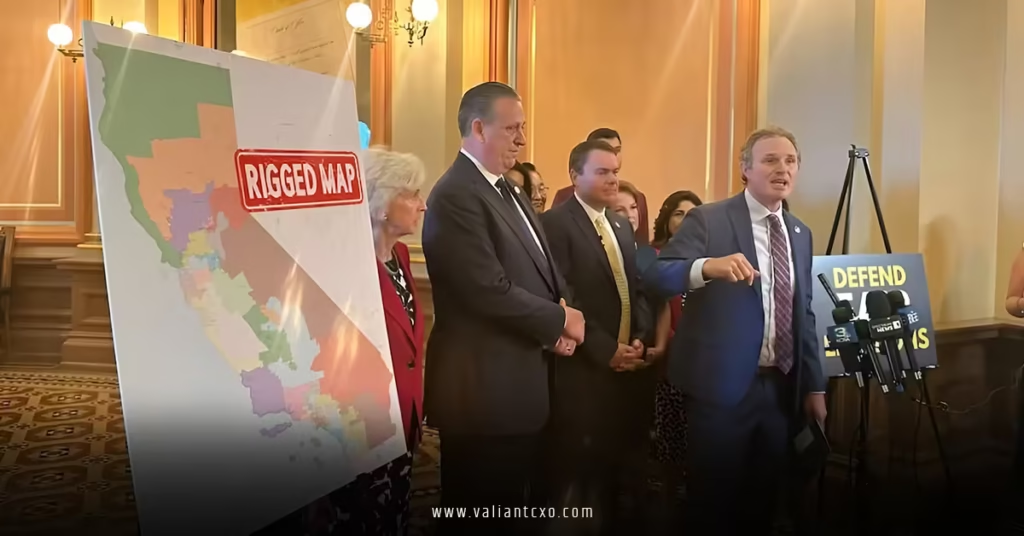Should California voters approve Prop 50 to redraw congressional districts against Texas gerrymandering in 2025? That’s the burning question on ballots across the Golden State this November 4, as we stare down a special election that could flip the script on national power plays. Imagine your vote not just picking a local rep, but countering a Lone Star State’s sneaky map shuffle that’s gunning for five extra Republican seats in Congress. Yeah, it’s that big. As a Californian who’s watched politics twist like a pretzel over the years, I can’t help but dive deep into this—because if we’re not talking about it now, when the stakes are sky-high for the 2026 midterms, then what’s the point of democracy?
Picture this: Texas Republicans, egged on by whispers from the White House, just rammed through a mid-decade redistricting blitz in August 2025. It’s classic gerrymandering—snaking district lines to pack Democrats into fewer areas, diluting their voices like sugar in too much iced tea. Now, California’s firing back with Proposition 50, a constitutional tweak that lets our state Legislature draw fresh maps for the next three election cycles. These aren’t neutral lines; they’re crafted to shield Democratic strongholds and potentially snag a few Republican-leaning districts, balancing the scales against Texas’s power grab. But is this savvy self-defense or a slide down the same slippery slope? Let’s unpack it, step by step, because you deserve the full scoop before you mark that ballot.
Understanding Gerrymandering: The Dirty Trick That’s Rigging America’s Maps
Have you ever wondered why elections sometimes feel like they’re rigged before the first vote’s cast? That’s gerrymandering in a nutshell—a sneaky art where politicians carve up districts to favor their party. It’s named after Elbridge Gerry, a Founding Father whose 1812 Massachusetts maps looked like a salamander (gerry + salamander = gerrymander). Fast-forward to today, and it’s a bipartisan bad habit, but right now, it’s Republicans in Texas leading the charge.
What Gerrymandering Looks Like in Practice
Think of it like stacking a deck of cards: You bunch all the aces (your voters) into one corner so the rest of the table gets weak hands. In Texas, the new maps target five Democratic-held seats, splitting urban Latino and Black communities across districts to weaken their clout. Civil rights groups are suing, yelling racial gerrymandering under the Voting Rights Act, but the state shrugs it off as pure partisan play—which the Supreme Court greenlit in 2019. Ouch. Meanwhile, California’s current setup, thanks to our independent Citizens Redistricting Commission, keeps things fairer: 43 Dems, 9 GOP in our 52 districts. But if Texas tips the national House further red, good luck passing progressive stuff like climate bills or healthcare expansions.
Why Mid-Decade Redistricting Feels Like Cheating
Normally, we redraw maps every 10 years after the census—like clockwork. But 2025? This is off-schedule chaos, sparked by President Trump’s team pressuring red states to lock in gains before 2026 midterms. Texas flipped the switch first, and now Missouri and Indiana are eyeing similar moves. It’s an arms race, folks, and California’s Prop 50 is our slingshot. Should California voters approve Prop 50 to redraw congressional districts against Texas gerrymandering in 2025? Absolutely feels like payback, but let’s see if it’s worth the hypocrisy.
The Spark: Texas’s Bold Gerrymander Move in 2025
Let’s rewind to June 2025. Trump’s inner circle starts nudging Texas GOP leaders: “Hey, why not tweak those lines now? Secure the House majority before Dems claw back.” Governor Greg Abbott calls a special session, Democrats bolt the state to bust quorum (classic Texas walkout), but Republicans muscle through anyway. By August 22, boom—new maps pass, aiming to bag 30 of Texas’s 38 House seats, up from 25.
How Texas’s Maps Dilute Minority Voices
These aren’t just lines on a page; they’re barriers. The redraw shreds “coalition districts”—areas where Black and Latino voters team up to elect reps who get them. Houston’s District 18? Gutted. San Antonio’s edges? Frayed. A federal trial kicked off October 1 in El Paso, with plaintiffs like the NAACP and MALDEF arguing it’s racial foul play. Texas counters: “Partisan only, Your Honor.” If it sticks, Republicans net five seats, tilting the House 220-215 their way. That’s oversight on Trump? Forget it.
National Ripples: Why California Can’t Sit This Out
Texas isn’t alone—Florida’s mulling tweaks, Indiana too. Analysts say this could add 7-10 GOP seats nationwide. California’s our counterweight: With 52 districts, flipping even three back could neutralize it. Enter Prop 50, born from Governor Newsom’s August 11 letter to Trump: “Pause your games, or we’ll play too.” It’s tit-for-tat, but in a system where rules bend for the bold, does playing dirty make us clean?
Proposition 50: California’s Counterpunch Explained
So, what exactly is Prop 50? Dubbed the “Election Rigging Response Act,” it’s a constitutional amendment hitting ballots November 4, 2025, via special election. A yes vote swaps our commission-drawn maps for Legislature-crafted ones through 2030—then back to independent in 2031 post-census. The new lines, penned in AB 604, tweak boundaries to make five GOP districts bluer, based on 2024 presidential results.
Breaking Down the New Maps: Winners and Losers
Pull out a map (or imagine one—North Cali stays solid blue, but Southern tweaks hit Inland Empire and Central Valley). District 13? Shifts from lean-GOP to toss-up. District 22? Ditto. Overall, it could net Dems three seats, per Ballotpedia crunching numbers: Kamala Harris would’ve won those flips by 7-10 points. Republicans cry foul, saying it packs their voters into safe zones, but hey, turnabout’s fair play. Fiscal hit? Minor—counties update ballots for under $10 million one-time.
The Legal Backbone: Why Voters Must Sign Off
California’s no slouch on reform—Prop 20 in 2010 birthed the Citizens Commission to kill politician meddling. But constitutions demand voter OK for tweaks, hence this ballot dance. Lawsuits fly: Four GOP lawmakers sued August 25, claiming rights violations; Trump’s DOJ eyes federal block. Newsom tweets back: “BRING IT.” Polls show 55% yes among Dems, but independents waver at 42%. Turnout’s key—special elections flop without it.

Should California Voters Approve Prop 50? Weighing the Pros and Cons
Alright, let’s get real: Should California voters approve Prop 50 to redraw congressional districts against Texas gerrymandering in 2025? It’s a gut-check. On one hand, it’s defensive jujitsu—using their tactics to shield ours. On the other, it chips at the fair-play fortress we built. Let’s list it out, because pros and cons aren’t black-and-white; they’re sunset orange.
The Strong Case for Yes: Fight Fire with Fire
First off, balance. Texas’s grab could lock in GOP House control, stalling Biden-era wins like infrastructure or green energy. Prop 50 evens it, potentially flipping seats without racial lines (Legislature swears it’s partisan pure). It’s temporary—four years max—reaffirming our commission love. Endorsements pour in: Obama, Harris, Pelosi, AFL-CIO. Campaign cash? $140 million yes vs. $75 million no, fueled by Soros and unions. As Newsom says, “We pick up five with voter consent—that’s democracy.”
Rhetorical nudge: If your neighbor cheats at Monopoly, do you quit or buy Boardwalk? Prop 50’s our hotel build. Plus, it nods to national reform: The measure urges Congress for independent commissions everywhere. Smart politics? Check. Moral high ground? Mostly.
The Case Against: Slippery Slope to Hypocrisy
But wait—aren’t we the good guys? California’s commission slashed gerrymandering post-2010; Prop 27 to kill it flopped 59-41%. Approving this feels like inviting vampires after banning garlic. Critics like the Protect Voters First coalition warn it dilutes Black votes in Oakland, packs Latinos in LA. Steve Hilton sued, citing outdated census data ignoring wildfires. And cost? Beyond bucks, trust erodes—voters feel played if pols redraw on whims.
Analogy time: It’s like fixing a leaky roof by punching more holes. Long-term, it greenlights everywhere mid-decade madness. Independents smell hypocrisy; polls dip when framed as “Dem gerrymander.” No vote keeps our maps pure till 2030—let courts smack Texas.
| Aspect | Pro-Yes (Approve Prop 50) | Pro-No (Reject Prop 50) |
|---|---|---|
| Impact on Seats | Nets Dems 3-5, counters Texas’s 5 | Keeps status quo: 43D-9R, risks national tilt |
| Fairness | Temporary defense, recommits to commissions | Upholds independent process, avoids precedent |
| Minority Representation | Protects urban coalitions | Risks dilution in tweaks, but current maps solid |
| Cost to Trust | Short-term hit for long win | Preserves voter faith in nonpartisan system |
| Endorsements | Dem heavyweights, unions | Bipartisan reformers, some GOP |
Bottom line? If survival trumps purity, yes. If principles reign, no. But in 2025’s trench warfare, can we afford saints?
Broader Implications: How Prop 50 Ripples to 2026 and Beyond
Zoom out: Should California voters approve Prop 50 to redraw congressional districts against Texas gerrymandering in 2025? It’s not just local chess; it’s national endgame. A yes could deadlock the House at 218-217, forcing bipartisanship—or gridlock. No? Texas wins, Trump agendas steamroll.
Effects on the 2026 Midterms and House Control
2026’s midterms loom huge—historically punish presidents. With Texas padding GOP, California’s no leaves Dems defending 15 toss-ups nationwide. Prop 50 flips three California battlegrounds: Think Rep. Young Kim’s OC seat going blue. Analysts at FiveThirtyEight model it: Yes boosts Dem odds to 52% House control. Plus, it bans “incumbent” labels in primaries—fresh blood!
Long-Term Democracy: Reform or Retaliation Cycle?
This arms race? Vicious. Missouri’s splitting Kansas City for one seat; Indiana eyes two. If Prop 50 passes, blue states like NY, IL might follow, but legal walls (constitutions, courts) block most. It spotlights reform: Push for national standards? Hell yes. Groups like FairVote cheer Prop 50’s commission pledge. But without it, gerrymandering festers, voter turnout tanks—why bother if rigged?
Personal take: I’ve voted in windy elections, from Prop 8 heartbreak to weed wins. This feels raw, like 2000’s recount redux. Prop 50’s messy, but passivity’s poison.
Voices from the Trenches: Endorsements, Campaigns, and Voter Buzz
Money talks: Yes on 50’s hauled $140M, no $75M—one of California’s priciest ever. Top yes donors: Soros ($10M), NEA ($3M). No: Munger Jr. ($33M), McCarthy ($1M). Ads blast: Yes shows Texas maps as “MAGA monsters”; no calls it “Dem dictatorship.”
Endorsements split party lines. Yes: CA Dem Party, Latino Victory Fund. No: LA Times editorial board, Sierra Club (fearing distraction). On X (formerly Twitter), #YesOn50 trends with memes of cowboy hats on snakes; #NoOn50 counters with commission heroes. Polls: 51% yes, 46% no, 3% undecided—tight as a guitar string.
Street level? I chatted with a Sacramento barista: “Texas cheats, we cheat back—fair’s fair.” An OC retiree: “Once you start, who stops?” It’s dividing friends, fueling barbecues.
Conclusion: Your Vote, Your Power—What’s It Gonna Be?
Whew, we’ve journeyed from Texas trails to California crossroads, dissecting if we should let pols redraw lines to slap back gerrymandering. Key takeaways? Prop 50’s a tactical yes for balance—countering five Texas seats with three of our own, temporary till 2031, recommitting to fair commissions. But it’s fraught: Risks trust, invites copycats, questions our reform cred. In this 2025 showdown, approving it fights fire with fire, shielding progressive wins amid Trump’s shadow. Don’t sit it out—mail that ballot, drop it off, vote in person. Democracy’s messy, but yours. Should California voters approve Prop 50 to redraw congressional districts against Texas gerrymandering in 2025? If leveling the field matters more than perfect purity, hell yeah. Your call could echo to 2026 and beyond—make it count.
Frequently Asked Questions (FAQs)
What exactly does Proposition 50 change if approved?
If should California voters approve Prop 50 to redraw congressional districts against Texas gerrymandering in 2025, it swaps the independent commission’s maps for Legislature-drawn ones through 2030, aiming to protect Democratic seats while pledging national reform.
How does Texas’s gerrymandering directly impact California?
Texas’s 2025 redraw could flip five Dem seats GOP, tilting House control and blocking CA priorities like environmental regs—making Prop 50 a direct shield if voters greenlight it.
Is Prop 50 just Democratic gerrymandering in disguise?
Critics say yes, but backers frame it as temporary retaliation. Should California voters approve Prop 50 to redraw congressional districts against Texas gerrymandering in 2025? It’s partisan, sure, but race-neutral and short-lived.
What happens if Prop 50 fails—do we stick with current maps?
Yep, the Citizens Commission’s 2021 lines hold till 2031. No change means no counter to Texas, potentially costing Dems national leverage.
Can Prop 50 really fix gerrymandering nationwide?
Not alone—it urges Congress for independent commissions everywhere. But approving it in 2025 spotlights the issue, pushing reform if California leads by example against Texas tricks.
For More Updates !! : valiantcxo.com


